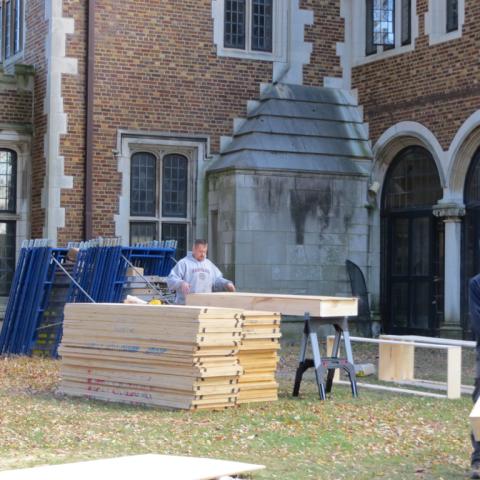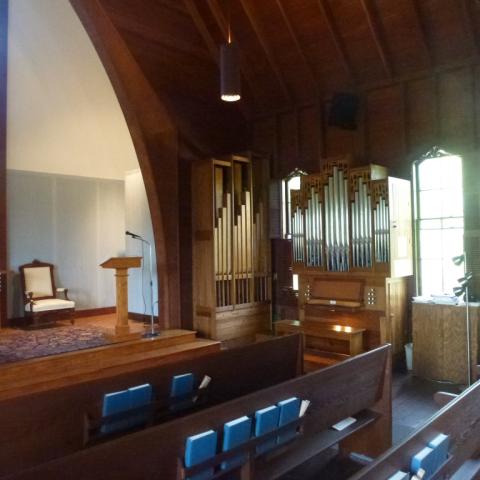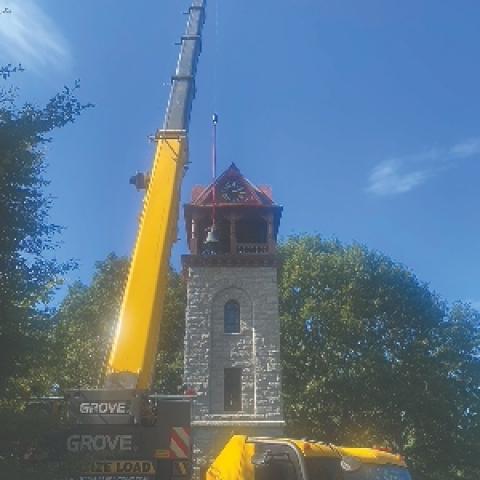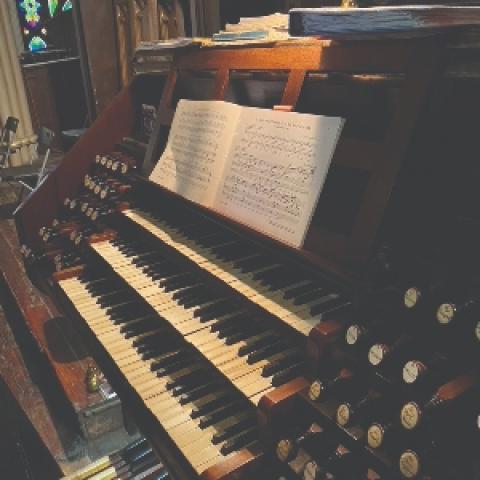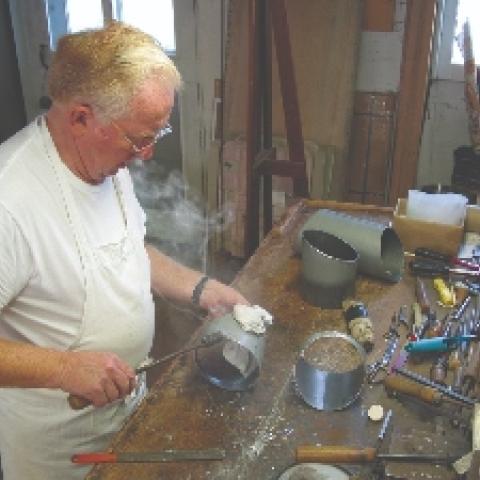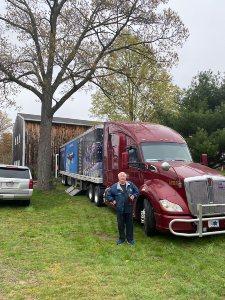
A moving experience
I have been involved in moving hundreds of pipe organs. Now that I am over the age of sixty-five, I have retired from active site work. I am not carrying heavy loads up or down stairs, climbing ladders with organ parts on my shoulder, walking backward carrying one end of a loaded pipe tray, or squiggling around on my ample belly under a windchest and around a reservoir to reach those last few windline screws. I am happy to leave all that to others. Along with gathering information about organs for sale, I correspond with clients and arrange the logistics for our jobs, such as scheduling truck transportation, ordering packing materials and lumber for crates, renting scaffolding, and planning travel and lodging for the crew.
When I joined the Organ Clearing House I faced a steep learning curve about the trucking industry. For the first few jobs I organized, I hired household moving companies with familiar names like Mayflower and Allied. One of those outfits carried a Beckerath organ for us from New York City to Los Angeles. The shipment was received by a crew from Beckerath who reported significant damage to the load. It was insured through the moving company, and an adjuster was dispatched to view the damage. The German crew told the adjuster that their methods of packing were different from ours, but in the awkwardness of different languages, the adjuster heard them saying that we did it wrong and the claim was denied. I replied that we were widely known for our many shipments without damage and asked if the adjuster would revisit our claim if I went to Los Angeles at our expense to present our case in person.
The organ had to be removed from the building in New York before a certain date and could not be delivered until after a certain date, so we were paying for several extra days for the loaded truck to sit waiting. As we discussed the claim, we discovered that the driver had used those extra days to visit family in the mountains of Tennessee, and police reports revealed that there had been a “mishap.” The claim was paid.
Loading an organ into another moving van in New Haven, Connecticut, I was chatting with the driver who happened to mention that it was good we were not shipping the organ to Canada because he had been banned from driving there because of a firearms violation. I called the dispatcher and demanded a different driver.
It was when a household mover stood us up that I learned a better way. The organ involved was the huge M. P. Möller (Opus 5819) from the 19,000-seat Philadelphia Civic Center that we were shipping to the University of Oklahoma for the then-nascent American Organ Institute, now sadly shuttered. The organ had only eighty-nine ranks, but they included four Tubas, a huge proportion of sixteen-foot stops, two whopping “thirty-twos,” two huge consoles (theatre and concert), and was so massively built that we figured we would need five semi-trailers to move it. The day before we were to start loading, I was waiting at a baggage carousel in the Philadelphia airport when the moving company called to tell me that they needed all their trucks for something else. My reaction attracted the attention of my fellow travelers.
Some months earlier, I received a call from Malcolm, an international shipping agent, who had an abandoned shipment of new organ pipes in a warehouse. An American organ builder had suddenly gone out of business before receiving the pipes from a European pipe maker. Malcolm found me through a Google search and asked for my help to sell them, which I was able to do quickly. After the call from the moving company, I pulled myself together, retrieved my keys from across the terminal, and called Malcolm. Sure enough, with only one day lost to the snafu, Bohemian Logistics of Reno, Nevada, sent us a truck each day for the rest of the week. Since then, Malcolm has arranged all our international shipments (except to Madagascar), sending organs to New Zealand, Australia, Germany, Bolivia, Japan, Indonesia, and Great Britain, among others.
Why not Madagascar? In 2008, we were sending an organ to Antananarivo at the request of Marc Ravalomanana, then president of the Republic, and he was using his considerable influence and staff to arrange for a shipping container. My colleague Amory Atkins and I flew to “Tana” to install it in time for an important anniversary celebration at the principal church of FJKM, the Church of Jesus Christ in Madagascar. Ravalomanana, who was also the president of the national church, would preach at the service. We were on a tight schedule, but the container was being delayed by customs at Toamasina, the country’s principal port. The president had just imposed unpopular new rules and regulations regarding imports, and the port authorities were retaliating by holding up his prize project.
Finally, the president brought in the military to sort things out, and the container was trucked to the presidential palace on the outskirts of Tana because city streets could not accommodate a large truck. With the help of the army, we transferred the organ onto a military flatbed truck, and our crew of soldiers rode on top of the load for the twenty miles to the church. It was a riot watching Amory give directions to the group of Malagash soldiers. A few months later, a popular uprising tossed President Ravalomanana out of office.
What you want in a truck
Most of the enclosed semi-trailers you see on the highway are simple big boxes with no equipment to secure a load. A truck backs up to a warehouse loading dock, and forklifts load them full of loaded shrink-wrapped pallets. The pallets are built to fit snugly in a standard truck, so it is not possible for the load to shift while the truck is in motion. Loading a pipe organ is like a huge and heavy game of Tetris. The crew studies the staged load and calculates what component would go where, filling voids with individually wrapped smaller parts and commercial padding.
Dave, the owner and one of the drivers of Bohemian Logistics, introduced us to “special commodities” fleets. Those trailers have vertical rails spaced every six or eight feet that have rows of holes like modular shelving to accept ratchet straps to secure things to the walls of the truck, and highway bars that reach from side to side, and can be used to brace uneven loads and to support decking, a second plywood floor inside the truck that can be loaded with well-wrapped larger metal pipes and the like. These specialty trucks are intended to handle unconventional loads like large trade shows and pipe organs, and are equipped with twenty- or twenty-five-dozen quilted furniture pads, hydraulic lift tailgates, ramps, and other assorted gear to help make an uneven load secure and easier to handle in and out of the trailer.
Bohemian Logistics ceased operations, and searching for a new source of special commodities trucks I found Roland Dickens, a dispatcher for Landstar Systems, a huge transit company with a considerable special commodities fleet. We have worked with Roland almost exclusively for the last ten years, and I have shared his name with many of our colleague companies. He is a whiz at sending us skillful drivers, and he plays and wins pool tournaments in Las Vegas.
Richard Mowen was one of the first drivers Roland sent us. He was a tiny wiry guy with a tiny wiry dog and a twangy southern accent; a member of our crew thought he was the spitting image of Bugs Bunny’s archrival, Yosemite Sam. Richard passed out bottles of his favorite cherry soda, cracked wise about our complicated load, swung himself aloft into the cab of his Kenworth, and took to the road with a blast from his horn. He has since retired but left behind a lot of memories.
It is a safe bet that Bob Mead transports more pipe organs each year than any other driver on the road. He is a favorite of ours and at least four other organ companies. He is devoted to the United States Armed Services and has “wrapped” his fifty-three-foot trailer with ceremonial photos depicting all the service branches along with a lengthy list of members of his family who have served. He is not available to us during December because he volunteers with Wreaths Across America, a nonprofit that places Christmas wreaths on every military grave in the country. He joins a huge fleet of trucks that meet in the downeast village of Harrington, Maine, where the wreaths are produced, and has the honor of leading a convoy into Arlington National Cemetery. I bet that colorful trailer wrap helped him secure that post. When the convoy leaves Harrington and heads south on Route 1 to I-295 to I-95, bridges over the highways are manned with platoons of police and firefighters, the fire trucks parked with their ladders raised in salute.
One of the first times Bob worked with us, we were dismantling the iconic Klais organ at Saint Peter’s Lutheran Church (nycago.org/Organs/NYC/html/StPeterLuth.html) on Lexington Avenue in New York City. (We called that job “Lex Luther.”) The church sold its land for the construction of the CitiCorp building at the corner of Fifty-third Street, and the development created a large contemporary worship space at ground level along with offices and gathering spaces for the church.
We were completing the job in the first days of February 2021, and the day before Bob was to arrive, a heavy snowstorm made a mess of the neighborhood. It seemed like a miracle that he drove down Lexington Avenue in the wee hours of the morning and parked his seventy-five-foot-long truck in front of the church as if he was going shopping. (That is the neighborhood where you can buy $50,000 purses.) Three weeks later, Bob joined us on Madison Avenue in Harlem where we had finished dismantling the glorious Roosevelt/Welte-Tripp organ (nycago.org/Organs/NYC/html/AllSaintsRC.html#WelteTripp). This was a two-truck organ, so Bob’s city parking magic placed two semis on the street in front of the church. Have you ever tried to find a parking space in Manhattan?
Back in the day
It is difficult enough to move pipe organs with modern semi-trailers and interstate highways, but think about the days before internal combustion engines. Ellsworth, Maine, is a small town “downeast” on the Union River, north of Deer Isle, and about thirty-five miles west of Harrington, the wreath capital. John Black of Ellsworth, Maine, ordered an organ from E. & G. G. Hook (Opus 168) in the fall of 1853 as a gift to the Congregational Church of Ellsworth where he was a pew subscriber, planning for it to be installed before New Year’s Day of 1854. On January 4, 1854, Mr. Black wrote to the company, “I assure you gentlemen that it is a very great disappointment to me that you did not get the organ finished and here before the New Year, for our congregation had anticipated the pleasure of hearing it on Sunday, the 1st January.”
The next week, Black wrote to his shipping agent
Messrs. E. & G. G. have built and packed an organ which they wish to send down by first opportunity. . . . Since the violent storm we have had extreme cold—thermometer ranging many degrees below zero, but the weather has suddenly changed and today we have a very severe rain, the thermometer being at 38 above, causing our snow to disappear very fast.
It was early February before the schooner Abigail Haynes docked in Boston and received the shipment of the Hook organ. On March 7, Black wrote: “Capt. Lord has had a long and tedious passage but I have the pleasure to inform you that he has at last arrived safe with the organ, which will probably be received here today.” And on March 8,
. . . yesterday she arrived in the waters at Coggins Wharf at the end of Newbury Neck. She came from Boston to Bucks Harbor in 24 hours and has been ever since getting round to Newbury Neck [about forty-five miles by water]. The reach and all the passages among the islands being closed by ice, she is a long distance from here, but trams can cross the bay on the ice in all directions and as the sledding is good, her freight can be got up without much trouble.
Once the organ was safely at Coggins Wharf, the flurry of anxious letters stopped, so we do not know just when the organ was delivered to the church in Ellsworth and played for the first time, but the Hook opus list shows that #168 with two manuals and twenty-one stops was delivered in 1854. I picture a fleet of horse-drawn sleds crossing the ice to the ship to receive the crated organ. A bill of lading states that the cost of the shipment was $26.10. The Hook organ was replaced in 1912.1
Wendy and I have sailed our Kingfisher in those waters around Stonington and Brooklin, Maine, Jericho Bay, and Blue Hill Bay to Newbury Neck. There are strong tidal currents swirling between the islands and the dozen or so bays in that area, and there are many rocks and ledges, so you had better pay close attention to where you are. We have a fancy new chart plotter mounted in the cockpit that shows our boat’s location within a few feet, and shows clearly all the dangers, including submerged rocks that you cannot see even in high tide that will tear the bottom off your boat in a heartbeat, and we only sail during the summer. We also have a diesel engine that keeps us out of trouble.
Captain Lord had nothing but primitive charts and a sextant. If he was blinded by snow or fog, he could either chance it or drop anchor. The Vineyard Gazette (Martha’s Vineyard, off Cape Cod) of October 18, 1878, reported damage from a violent storm that included cows, chimneys, barns, and houses along with more than twenty ships destroyed. During that storm, the Abigail Haynes was dismasted in a collision with the schooner Florence Newell of Philadelphia.
Keep rolling.
I admire the guys who help us transport pipe organs. It is a special skill to get a shipment from one place to another on-time, especially when dealing with bad weather. Drivers like these replace the engines in their trucks every million miles or so and aim for records like two million accident-free miles. One driver shared his homespun wisdom about driving in mountains, “I can go down that hill too slow as many times as I want. I can only go down too fast once.”
We get to be friends as we see them repeatedly, and they draw genuine pleasure from being associated with our work. While many truckers come and go only from commercial warehouses with loading docks and huge tarmac aprons, our drivers must back their trucks into church parking lots and tight alleys. It is fun to watch a driver walk around his rig, pacing out distances, calculating how he will make it happen. And they always do. When they are loaded and getting ready to leave, the salutation is “shiny side up.”
Notes
1. The letters of John Black are quoted with permission from Woodlawn Museum, Gardens & Park of Ellsworth, Maine, the former estate of three generations of the Black family, Kathy Young, executive director.

